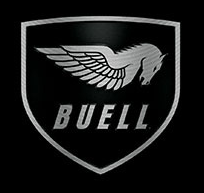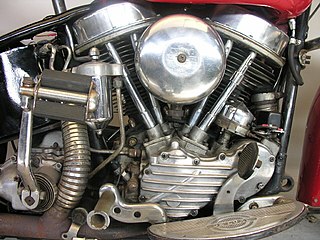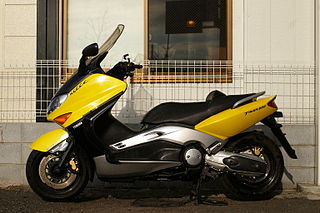
Indian Motorcycle is an American brand of motorcycles owned and produced by American automotive manufacturer Polaris Inc.

The Honda VF and VFR series is a range of motorcycles first introduced in 1982 by Honda featuring V4 engines.

Buell Motorcycles is an American motorcycle manufacturer based in Grand Rapids, Michigan, United States. It was founded in 1983 by ex-Harley-Davidson engineer Erik Buell. Harley-Davidson acquired 49 percent of Buell in 1993, and Buell became a wholly owned subsidiary of Harley-Davidson by 2003. On November 17, 2006, Buell announced that it had produced and shipped its 100,000th motorcycle.

A softail motorcycle intentionally looks like vintage motorcycles with a rigid hard-tail frame that has a triangle of steel tubes at the rear axle, as on a bicycle frame, but on a Softail these tubes are actually a triangular swingarm, with the shock absorber(s) hidden, as opposed to clearly visible regular twin shocks on both sides of the rear wheel on standard bikes. Since the introduction of the Harley-Davidson FXST Softail in 1983 as a registered trademark of the Motor Company, softail has become a genericized trademark for other models of cruiser motorcycles with rear suspensions hidden for retro style reasons. This was done even though the rear wheel was often hidden behind bags or exhaust pipes.

The Honda VFR750F is a motorcycle manufactured by Japanese automobile manufacturer Honda from 1986 to 1997.

The BMW GS series of one purpose off-road/on-road BMW motorcycles have been produced from 1980, when the R80G/S was launched, to the present day. The GS refers to either Gelände/Straße or Gelände Sport. GS motorcycles can be distinguished from other BMW models by their longer travel suspension, an upright riding position, and larger front wheels – typically 19 to 21 inch. In May 2009, the 500,000th GS was produced, an R1200GS model.

The Suzuki GSX-R750 is a sports motorcycle made by Suzuki since 1984. It was introduced at the Cologne Motorcycle Show in October 1984 as a motorcycle of the GSX-R series for the 1985 model year.

The Cotton Motor Company, was a British motorcycle manufacturer of 11a Bristol Road, Gloucester, and was founded by Frank Willoughby Cotton in 1918. F.W. presided over the company until his retirement in 1953. The company was reconstituted as E. Cotton (Motorcycles) Ltd, and traded until 1980. The marque was later resurrected in the late 1990s by a business which manufactured replicas of earlier machines.

The Ner-A-Car was a type of feet forwards motorcycle designed by Carl Neracher in 1918. It used an unusual steel-channel chassis, much like an automobile, and hub-center steering at the front wheel, making it 'nearly a car' in design. The Ner-A-Car was the most successful hub-center steering motorcycle ever produced, with sales far eclipsing earlier or later examples of this design, such as the Yamaha GTS1000 or Bimota Tesi. About 10,000 Neracars were manufactured in the United States by the Ner-A-Car Corporation, while around 6,500 are believed to have been produced in England under licence by the Sheffield-Simplex company between 1921 and 1926 under the Ner-A-Car name.

The R60 and R60/2 are 600 cc boxer-twin that were manufactured from 1956 to 1969 in Munich, Germany, by BMW.

Tempo was a Norwegian motorcycle and moped brand. Jonas Øglænd made the rolling chassis and most of the parts thereof, and Fichtel & Sachs AG made the engines for the majority of the models. After 1972 the company made mopeds only.

Harley-Davidson FL is a model designation used for Harley-Davidson motorcycles since 1941, when F referred to the new large capacity 74 cui (1200cc) variant of the V-2 Overhead valve engine (″Knucklehead″) that was introduced in 1936 as Model E with 61 cui (1000cc). The presence of an additional letter L indicated higher compression, offering more power but requiring higher octane gasoline. In 1950s, the low compression version was discontinued, and in 1952 also the low capacity EL, making FL the standard engine and model designation for decades to come.

The Kawasaki Ninja ZX-9R is a motorcycle in the Ninja sport bike series from Japanese manufacturer Kawasaki, produced from 1994 until 2003. There were five model incarnations across two basic designs.

A motorcycle frame is a motorcycle's core structure. It supports the engine, provides a location for the steering and rear suspension, and supports the rider and any passenger or luggage. Also attached to the frame are the fuel tank and battery. At the front of the frame is found the steering head tube that holds the pivoting front fork, while at the rear there is a pivot point for the swingarm suspension motion. Some motorcycles include the engine as a load-bearing stressed member; while some other bikes do not use a single frame, but instead have a front and a rear subframe attached to the engine.

The third-generation Mustang was produced by Ford from 1979 until 1993. Built on Ford's Fox platform, it is commonly referred to as the Fox body Mustang. It evolved through several sub-models, trim levels, and drivetrain combinations during its production life. It underwent updates for the 1987 model year and seemed destined for replacement with a front-wheel drive Mazda platform. However, company executives were swayed by consumer opinion and the rear-wheel drive Mustang stayed, while the front-wheel drive version was renamed the Ford Probe. Enthusiasts group the generation into two segments: the 1979–1986 cars, with their quad headlight arrangement, and the 1987–1993 cars, with their aerodynamic composite headlamps and front fascia styling. Production ended with the introduction of the fourth-generation Mustang (SN-95) for the 1994 model year.

The Aprilia Tuono is a naked motorcycle manufactured by Aprilia from 2002. It is based on the Aprilia RSV Mille. Its successor, the Aprilia RSV1000R superbike shares its engine, gearbox, frame and, partly, its suspension. The Tuono was succeeded by the Aprilia Tuono V4 R for model year 2011, though the V2 model continued in production into the 2011 model year.

The Indian Scout is a motorcycle built by the Indian Motocycle Company from 1920 to 1949. It rivaled the Chief as Indian's most important model. The 101 Scout, made from 1928 to 1931, has been called the best motorcycle Indian ever made. A second line of Scouts, with heavier frames, was introduced in 1932 alongside the Standard Scout, which replaced the 101 Scout and shared its frame with the Chief and the Four. The small-displacement Scout and the Sport Scout, introduced in 1934, were continued until the end of civilian production in 1942. Military versions of both models were used by US and other Allied forces during World War II.
The James Comet was a 98 cubic centimeter (cc), two-stroke, motorcycle manufactured by the James Cycle Co. and announced on 21 October 1948. A post-World War II design, the Comet went into production in late 1948.

The Yamaha TMAX series of maxi-scooters has been manufactured by Yamaha Motor Company for the European market since its debut at July 2000 press events in Naples, Italy and Iwata, Japan, combining motorcycle performance with the convenience and flexibility for commuting of a scooter.

The Imme R100 was a lightweight motorcycle made by Riedel AG from 1948 to 1951. It is noted for its simple and innovative design with many advanced features. With low cost and technical innovation, the R100 sold well, but reliability problems and low profit margins resulted in warranty costs driving Riedel AG into bankruptcy.




















